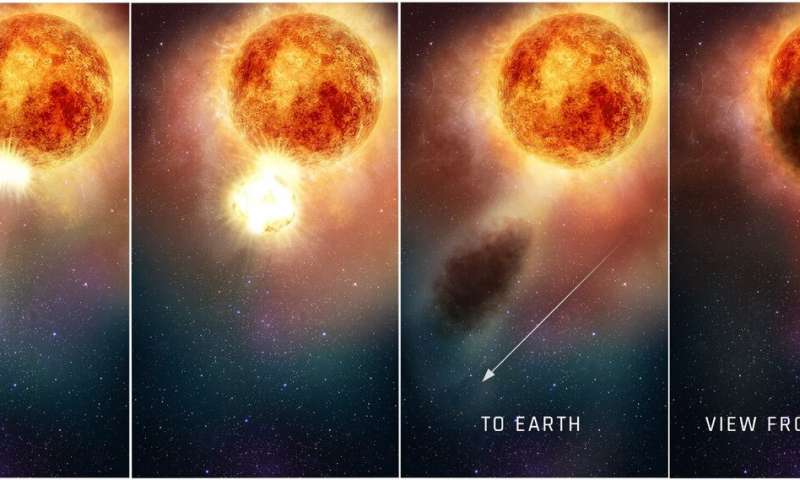HOME
Hubble finds that Betelgeuse's mysterious dimming is due to a traumatic outburst

This four-panel graphic illustrates how the southern region of the rapidly evolving, bright red supergiant star Betelgeuse may have suddenly become fainter for several months during late 2019 and early 2020. In the first two panels, as seen in ultraviolet light with the Hubble Space Telescope, a bright, hot blob of plasma is ejected from the emergence of a huge convection cell on the star's surface. In panel three, the outflowing expelled gas rapidly expands outward. It cools to form an enormous cloud of obscuring dust grains. The final panel reveals the huge dust cloud blocking the light (as seen from Earth) from a quarter of the star's surface. Credit: NASA, ESA, and E. Wheatley (STScI)
Recent observations of Betelgeuse have revealed that the star's unexpected and significant dimming periods in late 2019 and early 2020 were most likely caused by the ejection and cooling of dense hot gases, and that the star may be going through another dimming period more than a year early.
Between October and November 2019, Hubble Space Telescope observed dense, heated material moving outward through the star's extended atmosphere at 200,000 miles per hour. The following month, several ground-based telescopes observed a decrease in brightness in Betelgeuse's southern hemisphere, as if something was blocking light in this region of the star. By February 2020, the star had lost more than two-thirds of its brilliance, a dimming visible even to the naked eye, creating buzz that the star might be going supernova. Continued ultraviolet light spectroscopic observations with Hubble provided a timeline for researchers to follow, like breadcrumbs leading back through time to pinpoint the source of the mysterious dimming.
"With Hubble, we had previously observed hot convection cells on the surface of Betelgeuse and in the fall of 2019 we discovered a large amount of dense hot gas moving outwards through Betelgeuse's extended atmosphere. We think this gas cooled down millions of miles outside the star to form the dust that blocked the southern part of the star imaged in January and February," said Andrea Dupree, associate director of the Center for Astrophysics | Harvard & Smithsonian, and lead author on the study. "The material was two to four times more luminous than the star's normal brightness. And then, about a month later the south part of Betelgeuse dimmed conspicuously as the star grew fainter. We think it possible that a dark cloud resulted from the outflow that Hubble detected. Only Hubble gives us this evidence that led up to the dimming."
News Source